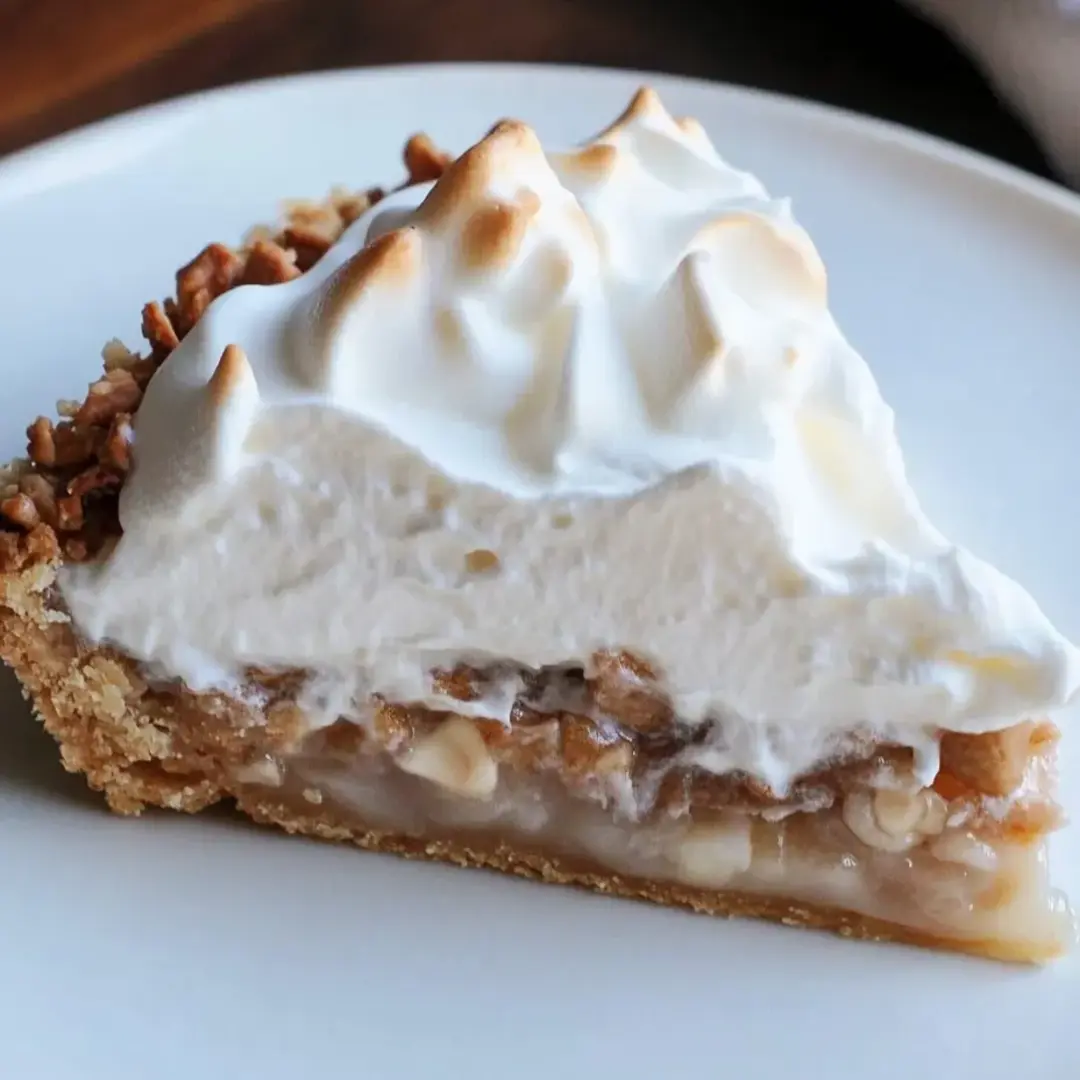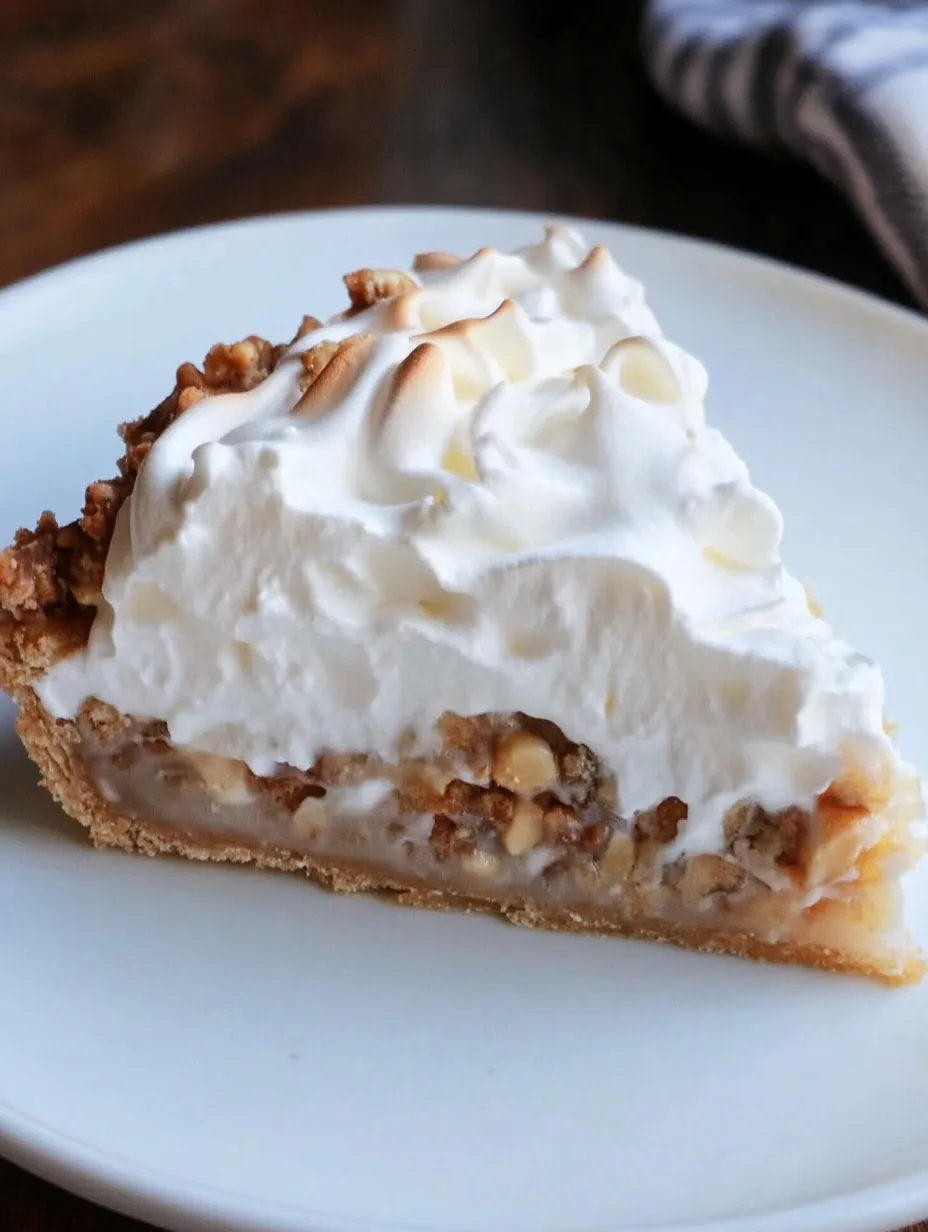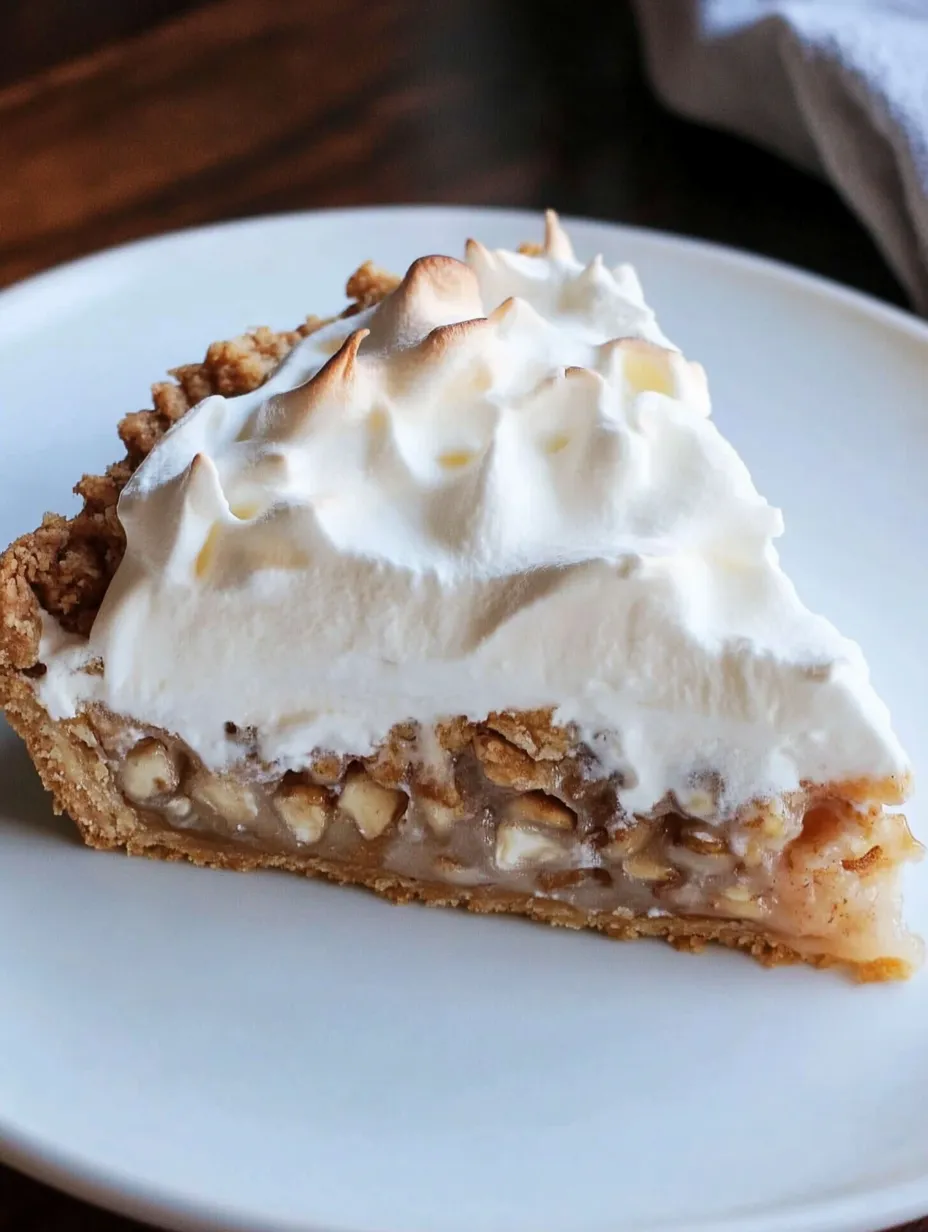 Pin it
Pin it
Old-Fashioned Stupid Pie transforms simple ingredients into an unforgettable dessert that defies expectations. This vintage treat features a cloud-like meringue base studded with buttery Ritz crackers and crunchy pecans, creating a perfect balance of textures in every bite. The edges bake to a delicate crispness while the center remains delightfully chewy, and the whole creation is crowned with a layer of billowy whipped topping. It's a dessert that proves how humble pantry staples can combine to create something truly magical – and it's high time this forgotten gem made its way back to our tables.
I served this pie at a family gathering recently, announcing it only as "a vintage dessert." Everyone was intrigued by the airy texture and unique flavor profile, and when I revealed its quirky name, it became the conversation piece of the evening. My uncle immediately recognized it as something his grandmother used to make in the 1950s!
Ingredients
- Egg whites: The foundation of the meringue base; fresh eggs separate more easily at room temperature
- Granulated sugar: Sweetens and stabilizes the meringue; fine sugar dissolves more readily
- Vanilla extract: Adds depth and warmth; pure extract gives the best flavor
- Ritz crackers: Provide buttery richness and salt to balance the sweetness; crush them roughly, not into fine crumbs
- Pecans: Add nutty flavor and texture; toasting them first enhances their flavor
- Whipped topping: Creates the cloud-like finish; homemade whipped cream can be substituted if preferred
- Salt: Just a pinch enhances all the flavors; fine sea salt works best
- Cream of tartar: Optional but helps stabilize the egg whites for a more reliable meringue
 Pin it
Pin it
Cooking Instructions
- Step 1:
- Prepare your oven and pan properly - Preheat your oven to 325°F (165°C). This moderate temperature allows the meringue to cook through without browning too quickly. Select a 9-inch pie plate or a shallow baking dish. Unlike traditional pies, this crustless wonder doesn't require any greasing or lining of the pan – the meringue will naturally release once baked. Position your oven rack in the center position for even baking.
- Step 2:
- Create the perfect meringue base - In a completely clean, dry mixing bowl, separate 3 large eggs, keeping only the whites and saving the yolks for another use. Room temperature egg whites whip more easily, so let them sit for about 30 minutes if they're straight from the refrigerator. Add a pinch of salt and ¼ teaspoon cream of tartar if using. Begin beating with an electric mixer on medium speed until the egg whites become foamy. Gradually increase to high speed and slowly add 1 cup of granulated sugar, about 2 tablespoons at a time, allowing each addition to incorporate before adding more. Continue beating until stiff, glossy peaks form – when you lift the beater, the peaks should stand straight up without folding over. The meringue should be smooth and not grainy when rubbed between your fingers. Finally, gently fold in 1 teaspoon of vanilla extract.
- Step 3:
- Incorporate the crackers and nuts with care - In a separate bowl, coarsely crush about 20 Ritz crackers (roughly 1 cup of pieces) – the pieces should be roughly the size of a dime, not pulverized into crumbs. Chop 1 cup of pecans into medium pieces, or use pre-chopped pecans. Using a rubber spatula, very gently fold the crackers and pecans into the meringue with a light hand. Use an under-and-over motion rather than stirring to preserve as much air in the meringue as possible. The goal is even distribution while maintaining the fluffiness of the egg whites. This gentle technique is key to the pie's signature texture.
- Step 4:
- Bake to perfection - Carefully spoon the meringue mixture into your ungreased pie plate, creating a slight depression in the center so the edges are slightly higher than the middle. This helps create the perfect base for the topping later. Place in the preheated oven and bake for 30-35 minutes. The meringue is done when the edges are lightly golden and crisp, while the center remains pale but is set. It may puff dramatically during baking and then settle as it cools – this is completely normal and creates the characteristic texture. Allow to cool completely in the pan on a wire rack, about 1-2 hours. The meringue will continue to set and develop its unique texture as it cools.
- Step 5:
- Add the finishing touch - Once the meringue base is completely cooled, spread 2 cups of whipped topping (or freshly whipped cream sweetened with 2 tablespoons of sugar and ½ teaspoon of vanilla) over the top. For visual appeal, create soft swirls and peaks with the back of a spoon or spatula. For the best texture contrast, chill the assembled pie in the refrigerator for at least 1 hour before serving. This allows the flavors to meld while maintaining the textural differences between the crisp edges, chewy center, and creamy topping. If desired, garnish with a few pecan halves or a light dusting of ground cinnamon just before serving.
I particularly love the textural contrast in this pie – the edges have a delicate crispness like a pavlova, while the center remains delightfully chewy with pockets of buttery cracker and nutty pecans. When I first made it, I was skeptical about the combination, but the way the salty, buttery crackers play against the sweet meringue creates a complexity you wouldn't expect from such simple ingredients!
 Pin it
Pin it
The Secret to Perfect Meringue
Creating a successful meringue is the foundation of this unique pie. Start with room temperature egg whites, which whip more efficiently than cold ones. Using super clean equipment is essential – even a trace of fat can prevent egg whites from reaching their full volume. A copper, glass, or stainless steel bowl works best, as plastic bowls can retain traces of fat even after washing.
When adding sugar, patience is key. Add it slowly, about a tablespoon at a time, allowing each addition to fully dissolve before adding more. This creates a stable, glossy meringue that won't weep or collapse. You can test if the sugar is fully dissolved by rubbing a bit of meringue between your fingers – it should feel smooth, not grainy.
If you're making this on a humid day, add an extra teaspoon of cornstarch to the sugar before incorporating it into the egg whites. The cornstarch helps absorb excess moisture, resulting in a crisper meringue even in challenging conditions.
Variations Worth Trying
While the classic version of Stupid Pie is wonderful, there are several variations worth exploring. For a chocolate twist, fold in 2 tablespoons of cocoa powder and use chocolate graham crackers instead of Ritz. To give it a citrus note, add 1 teaspoon of lemon or orange zest to the meringue.
During the holidays, try incorporating seasonal spices like cinnamon, nutmeg, and cloves. For a summery version, layer fresh berries between the meringue base and whipped topping. If you're feeling adventurous, experiment with different nuts – walnuts or macadamia nuts make excellent substitutes for the pecans.
For a more decadent version, drizzle the finished pie with caramel sauce or chocolate ganache. These simple additions can transform this vintage dessert into a modern showstopper while maintaining its charm and unique texture.
This delightful vintage dessert represents everything I love about classic American recipes – it's unpretentious, ingenious in its simplicity, and delivers a surprising complexity of flavors and textures. Perhaps its humble name has kept it from reaching the culinary stardom it deserves, but one bite is enough to understand why it's been treasured in community cookbooks and family recipe boxes for generations. In our era of complicated desserts with long ingredient lists, there's something refreshingly straightforward about Stupid Pie. It reminds us that culinary magic often happens when simple ingredients come together in unexpected ways – and that's a lesson worth reviving, one slice at a time.
Frequently Asked Questions
- → Why is it called 'stupid pie'?
- The name 'stupid pie' likely comes from the surprisingly simple combination of ingredients that might seem 'stupid' or odd together but actually create a delicious dessert. Vintage recipes often had quirky names based on their unusual ingredient combinations.
- → Can I use a different type of cracker?
- Yes, while Ritz crackers provide that perfect buttery, salty contrast to the sweet meringue, you could substitute with similar butter crackers like Club crackers or even saltines for a slightly different flavor profile.
- → What does the texture of stupid pie feel like?
- The texture is quite unique - the outside is slightly crisp from the baked meringue while the inside becomes chewy and almost marshmallow-like. The crackers soften a bit during baking but still provide some texture along with the crunchy pecans.
- → Can I make this pie ahead of time?
- Yes, you can make the meringue base a day ahead and store it covered in the refrigerator. Add the whipped topping shortly before serving, or up to a few hours ahead if using Cool Whip, which is more stable than fresh whipped cream.
- → What can I substitute for pecans if I have a nut allergy?
- For a nut-free version, you could try using toasted sunflower seeds, additional crushed crackers, or even chocolate chips. The texture will be different, but it will still create an interesting contrast with the meringue base.
